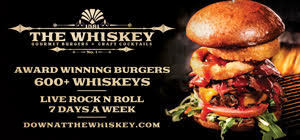It’s surprising how few really good Southern restaurants we have here, seeing as how close the South is to us and all. (Florida doesn’t consider itself to be part of the south, from what I can determine. The South is something you travel North to get to.
I believe I could happily subsist solely on the sides dished from Mama Nems’, a soul food restaurant on the west side of Orlando. Not that I’d want to do without the fried chicken, smothered pork chops or braised oxtails, but if I had to I could more than get by on the collard greens, black-eyed peas, stewed tomatoes and mashed potatoes if I had to. And at Mama Nems’, man could indeed live on cornbread alone.
The restaurant refers to its menu as comfort food for the soul, and its slogan is, “If your mama can’t cook it, Mama Nems’ can.” It’s an interesting challenge to the theory that many adhere to – including me – that when people go out to eat at a restaurant they want food they can’t cook at home, at least not easily. But here you have home-style foods, any number of which were probably mainstays of your family’s weeknight and Sunday dinners, the kinds of foods that most of us no longer prepare ourselves because we don’t have the time or the talent.
There is definitely talent in Mama Nems’ kitchen, but it isn’t Mama Nems because there is no such person. The name is an Ebonics translation of mama and them’s, as in someone saying he was going to Mama and them’s house, it becomes Mama nems’.
If the grammar police decide to invade the Kirkman road restaurant, I suggest the owners immediately feed them the “lip smacking” pot roast ($9.95), and all concerns of language misappropriation will be forgiven, or at least forgotten. This is how pot roast should be done, braised until the meat is tender and falls apart in chunks, not until it is dry and stringy. The serving was an ample portion for the price, but then factor in a choice of three side dishes and a cornbread muffin and the meal becomes a tremendous bargain.
In fact precious few of the entrees, which indeed are called mainstays, wander over the 10 dollar mark. One item was the braised oxtails ($11.95), a plateful of coin-sized morsels of bone surrounded by rich meat that fairly melts before it can be chewed.
The smothered pork chops ($8.95), two thin chops, were like the hundreds I had as a kid, meat that requires some careful chewing to avoid the gristle but flavorful from frying and covered with gravy made from pan drippings.
The three-piece fried chicken dinner ($7.95) featured crispy skin and moist meat, all perfectly seasoned. But there was one disappointment: choosing all dark meat got me one leg and two back portions, not nearly enough meat.
No qualms with the meatloaf ($7.95), two slabs of smooth-textured meat, mildly seasoned and covered with gravy. Mashed potatoes were an easy selection as one of the three side dishes, and they were delicious. Choosing the others is a more difficult decision, especially knowing that each has something to recommend it. The collard greens had an intensely earthy flavor without being too tart. Candied yams were sufficiently sweet on the surface but were pure tuber inside. Stewed tomatoes were pulpy red with just a touch of sweetness. Cheese and macaroni was indeed cheesy enough to warrant the top billing, but what I liked most about this one was the toasty crust from baking. Savory cabbage had a delightful pungency. But the black-eyed peas, tender-firm and slightly salty, were my favorite. If you don’t count the fried okra. Or the lima beans.
Dessert brought the only other disappointment in a dried out piece of sweet potato pie ($2.50). But the peach cobbler ($2.95) with a sugary crust and firm pieces of peach more than made up for it. And the banana pudding ($2.95), made with vanilla wafers, was absolute heaven. Miss Celia’s red velvet cake ($3.50) earned its name with a texture that was as smooth and moist and positively velutinous.
The staff were friendly and welcoming though at times could be overwhelmed with the task of dealing with more than two tables at a time. On one visit I was served cornbread and slices of seedless watermelon before my meal; on another visit I had to request the bread, and no watermelon was offered.
Mama Nems’ is in the Beacon Pointe Plaza next to Sanctuary of Praise church, which owns both the complex and the restaurant. Needless to say, no alcoholic beverages are served, although for some reason a nonalcoholic daiquiri is offered.
The restaurant could not be described as fancy, but it is neat and bright and still has a newness after three months. There is a separate area next to the dining room for takeout service. Many of the dishes are on display there, which is nice if you want to do some window shopping before you sit down to order.
Be aware that while the mainstays and side dishes lists are extensive not everything is available every day. Chitterlings and hog maws, for example, are offered only a few days of the week. If you have a hankering for a certain item, you may want to call ahead. Or just show up and after your initial disappointment you’ll find yourself immersed in something else just as wonderful. It would be very difficult to go wrong with anything cooked by Mama or any of them.









